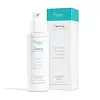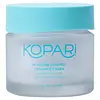What's inside
What's inside
 Key Ingredients
Key Ingredients

 Benefits
Benefits

 Concerns
Concerns

 Ingredients Side-by-side
Ingredients Side-by-side

Water
Skin ConditioningSqualane
EmollientDecyl Cocoate
EmollientGlycerin
HumectantButyrospermum Parkii Butter
Skin ConditioningGlyceryl Stearate Citrate
EmollientCetearyl Alcohol
EmollientPanthenol
Skin ConditioningPrunus Amygdalus Dulcis Oil
Skin ConditioningCeramide NP
Skin ConditioningTocopherol
AntioxidantCentella Asiatica Leaf Extract
Skin ConditioningGlyceryl Stearate
EmollientHydroxyacetophenone
Antioxidant1,2-Hexanediol
Skin ConditioningCaprylyl Glycol
EmollientSodium Stearoyl Glutamate
CleansingSodium Hyaluronate
HumectantButylene Glycol
HumectantCaprylic/Capric Triglyceride
MaskingHydrogenated Phosphatidylcholine
EmulsifyingHelianthus Annuus Seed Oil
EmollientCitric Acid
BufferingAsiaticoside
AntioxidantPentylene Glycol
Skin ConditioningMadecassic Acid
Skin ConditioningAsiatic Acid
Skin ConditioningXanthan Gum
EmulsifyingWater, Squalane, Decyl Cocoate, Glycerin, Butyrospermum Parkii Butter, Glyceryl Stearate Citrate, Cetearyl Alcohol, Panthenol, Prunus Amygdalus Dulcis Oil, Ceramide NP, Tocopherol, Centella Asiatica Leaf Extract, Glyceryl Stearate, Hydroxyacetophenone, 1,2-Hexanediol, Caprylyl Glycol, Sodium Stearoyl Glutamate, Sodium Hyaluronate, Butylene Glycol, Caprylic/Capric Triglyceride, Hydrogenated Phosphatidylcholine, Helianthus Annuus Seed Oil, Citric Acid, Asiaticoside, Pentylene Glycol, Madecassic Acid, Asiatic Acid, Xanthan Gum
Water
Skin ConditioningGlycerin
HumectantCaprylic/Capric Triglyceride
MaskingOctyldodecanol
EmollientDicaprylyl Ether
Emollient2,3-Butanediol
HumectantGlyceryl Stearate Citrate
EmollientCetearyl Alcohol
Emollient1,2-Hexanediol
Skin ConditioningSqualane
EmollientButyrospermum Parkii Butter
Skin ConditioningBehenyl Alcohol
EmollientHydrogenated Lecithin
EmulsifyingPolyglyceryl-10 Stearate
Skin ConditioningSodium Polyacrylate
AbsorbentBehenic Acid
CleansingStearic Acid
CleansingStearyl Alcohol
EmollientCocos Nucifera Fruit Extract
EmollientMyristic Acid
CleansingSimmondsia Chinensis Seed Oil
EmollientCeramide NP
Skin ConditioningTriethylhexanoin
MaskingPhospholipids
Skin ConditioningEthylhexylglycerin
Skin ConditioningHydrogenated Polydecene
EmollientAdansonia Digitata Seed Oil
EmollientCitrullus Lanatus Seed Oil
EmollientGlyceryl Undecylenate
EmollientGlyceryl Caprylate
EmollientCholesterol
EmollientPropanediol
SolventPhytosphingosine
Skin ConditioningTocopherol
AntioxidantAloe Barbadensis Leaf Juice
Skin ConditioningAdansonia Digitata Fruit Extract
EmollientXanthan Gum
EmulsifyingSodium Hyaluronate
HumectantWater, Glycerin, Caprylic/Capric Triglyceride, Octyldodecanol, Dicaprylyl Ether, 2,3-Butanediol, Glyceryl Stearate Citrate, Cetearyl Alcohol, 1,2-Hexanediol, Squalane, Butyrospermum Parkii Butter, Behenyl Alcohol, Hydrogenated Lecithin, Polyglyceryl-10 Stearate, Sodium Polyacrylate, Behenic Acid, Stearic Acid, Stearyl Alcohol, Cocos Nucifera Fruit Extract, Myristic Acid, Simmondsia Chinensis Seed Oil, Ceramide NP, Triethylhexanoin, Phospholipids, Ethylhexylglycerin, Hydrogenated Polydecene, Adansonia Digitata Seed Oil, Citrullus Lanatus Seed Oil, Glyceryl Undecylenate, Glyceryl Caprylate, Cholesterol, Propanediol, Phytosphingosine, Tocopherol, Aloe Barbadensis Leaf Juice, Adansonia Digitata Fruit Extract, Xanthan Gum, Sodium Hyaluronate
 Reviews
Reviews

Ingredients Explained
These ingredients are found in both products.
Ingredients higher up in an ingredient list are typically present in a larger amount.
1,2-Hexanediol is a synthetic liquid and another multi-functional powerhouse.
It is a:
- Humectant, drawing moisture into the skin
- Emollient, helping to soften skin
- Solvent, dispersing and stabilizing formulas
- Preservative booster, enhancing the antimicrobial activity of other preservatives
This ingredient is also known as shea butter. It is an effective skin hydrator and emollient.
Emollients help soothe and soften your skin. It does this by creating a protective film on your skin. This barrier helps trap moisture and keeps your skin hydrated. Emollients may be effective at treating dry or itchy skin.
Shea butter is rich in antioxidants. Antioxidants help fight free-radicals, or molecules that may harm the body. It is also full of fatty acids including stearic acid and linoleic acid. These acids help replenish the skin and keep skin moisturized.
While Shea Butter has an SPF rating of about 3-4, it is not a sunscreen replacement.
Shea butter may not be fungal acne safe. We recommend speaking with a professional if you have any concerns.
Learn more about Butyrospermum Parkii ButterThis ingredient is an emollient, solvent, and texture enhancer. It is considered a skin-softener by helping the skin prevent moisture loss.
It helps thicken a product's formula and makes it easier to spread by dissolving clumping compounds.
Caprylic Triglyceride is made by combining glycerin with coconut oil, forming a clear liquid.
While there is an assumption Caprylic Triglyceride can clog pores due to it being derived from coconut oil, there is no research supporting this.
Learn more about Caprylic/Capric TriglycerideCeramide NP is a type of ceramide and formally known as ceramide 3.
Ceramides are intercellular lipids naturally found in our skin that bonds dead skin cells together to create a barrier. They are known for their ability to hold water and thus are a great ingredient for dry skin.
Ceramides are an important building block for our skin barrier. A stronger barrier helps the skin look more firm and hydrated. By bolstering the skin ceramides act as a barrier against irritating ingredients. This can help with inflammation as well.
If you would like to eat ceramides, sweet potatoes contain a small amount.
Read more about other common types of ceramides here:
Ceramide AP
Ceramide EOP
Cetearyl alcohol is a mixture of two fatty alcohols: cetyl alcohol and stearyl alcohol. It is mainly used as an emulsifier. Emulsifiers help prevent the separation of oils and products. Due to its composition, it can also be used to thicken a product or help create foam.
Cetearyl alcohol is an emollient. Emollients help soothe and hydrate the skin by trapping moisture.
Studies show Cetearyl alcohol is non-toxic and non-irritating. The FDA allows products labeled "alcohol-free" to have fatty alcohols.
This ingredient is usually derived from plant oils such as palm, vegetable, or coconut oils. There is debate on whether this ingredient will cause acne.
Due to the fatty acid base, this ingredient may not be Malassezia folliculitis safe.
Learn more about Cetearyl AlcoholGlycerin is already naturally found in your skin. It helps moisturize and protect your skin.
A study from 2016 found glycerin to be more effective as a humectant than AHAs and hyaluronic acid.
As a humectant, it helps the skin stay hydrated by pulling moisture to your skin. The low molecular weight of glycerin allows it to pull moisture into the deeper layers of your skin.
Hydrated skin improves your skin barrier; Your skin barrier helps protect against irritants and bacteria.
Glycerin has also been found to have antimicrobial and antiviral properties. Due to these properties, glycerin is often used in wound and burn treatments.
In cosmetics, glycerin is usually derived from plants such as soybean or palm. However, it can also be sourced from animals, such as tallow or animal fat.
This ingredient is organic, colorless, odorless, and non-toxic.
Glycerin is the name for this ingredient in American English. British English uses Glycerol/Glycerine.
Learn more about GlycerinGlyceryl Stearate Citrate is a citric acid ester of glyceryl stearate.
It is an emulsifier, emollient, and a surfactant.
Emulsifiers help stabilize a product. It does this by preventing certain ingredients from separating. Common ingredients include oils and water, which do not mix naturally. Emulsifiers have properties that help keep ingredients such as these together.
Emollients help soothe and soften the skin. They do this by creating a protective film on your skin. This barrier helps trap moisture and keeps your skin hydrated. Emollients may be effective at treating dry or itchy skin.
Surfactants help gather oils, dirt, and other pollutants from the skin. This helps them to be easily rinsed away.
Learn more about Glyceryl Stearate CitrateSodium Hyaluronate is hyaluronic acid's salt form. It is commonly derived from the sodium salt of hyaluronic acid.
Like hyaluronic acid, it is great at holding water and acts as a humectant. This makes it a great skin hydrating ingredient.
Sodium Hyaluronate is naturally occurring in our bodies and is mostly found in eye fluid and joints.
These are some other common types of Hyaluronic Acid:
Learn more about Sodium HyaluronateSqualane is an emollient that helps the skin hold onto moisture. It's an oily liquid that occurs naturally in certain types of fish and plant oils.
Because squalane boosts hydration in the skin, it also comes with plenty of benefits: it is an antioxidant and can help fight free radicals and skin damage. Squalane is also found to have a detoxifying effect when applied.
Squalane comes from squalene, which occurs naturally within the sebum of our skin. It is one of the oils our skin produces to keep itself hydrated. Squalane is the hydrogenated version of squalene and has a longer shelf life.
Research shows that squalane is non-irritating (even at 100% concentration).
In general, it's a fantastic ingredient. It does a great job at hydrating the skin, and it's suitable for those with sensitive skin.
The source of squalane may impact malassezia / fungal acne. This is because olive oil derived squalane can contain impurities such as fatty acids and plant waxes. Sugarcane derived squalane is recommended for anyone with malassezia concerns.
Is squalane vegan?
This depends on the source. Squalane can be derived from both plants and animals. Most squalane used in skincare comes from plants.
Please note: the source of squalane is only known if disclosed by the brand. We recommend reaching out to the brand if you have any questions about their squalane.
Read more about squalene with an "e".
Is squalane an oil?
Squalane is often called an oil, but it’s technically not; it’s a hydrocarbon, meaning it’s only made of carbon and hydrogen, unlike true oils which are triglycerides made of fatty acids and glycerol.
The term “oil-free” isn’t regulated, so companies can define it however they want. Some exclude all oils, while others just avoid mineral oil or comedogenic oils.
While some people avoid oils thinking they cause breakouts, the right kind of oil (or oil-like ingredient like squalane) can actually help balance and hydrate your skin. It’s worth testing out simple oils or squalane to see what works best for your skin.
Learn more about SqualaneTocopherol (also known as Vitamin E) is a common antioxidant used to help protect the skin from free-radicals and strengthen the skin barrier. It's also fat soluble - this means our skin is great at absorbing it.
Vitamin E also helps keep your natural skin lipids healthy. Your lipid skin barrier naturally consists of lipids, ceramides, and fatty acids. Vitamin E offers extra protection for your skin’s lipid barrier, keeping your skin healthy and nourished.
Another benefit is a bit of UV protection. Vitamin E helps reduce the damage caused by UVB rays. (It should not replace your sunscreen). Combining it with Vitamin C can decrease sunburned cells and hyperpigmentation after UV exposure.
You might have noticed Vitamin E + C often paired together. This is because it is great at stabilizing Vitamin C. Using the two together helps increase the effectiveness of both ingredients.
There are often claims that Vitamin E can reduce/prevent scarring, but these claims haven't been confirmed by scientific research.
Learn more about TocopherolWater. It's the most common cosmetic ingredient of all. You'll usually see it at the top of ingredient lists, meaning that it makes up the largest part of the product.
So why is it so popular? Water most often acts as a solvent - this means that it helps dissolve other ingredients into the formulation.
You'll also recognize water as that liquid we all need to stay alive. If you see this, drink a glass of water. Stay hydrated!
Learn more about WaterXanthan gum is used as a stabilizer and thickener within cosmetic products. It helps give products a sticky, thick feeling - preventing them from being too runny.
On the technical side of things, xanthan gum is a polysaccharide - a combination consisting of multiple sugar molecules bonded together.
Xanthan gum is a pretty common and great ingredient. It is a natural, non-toxic, non-irritating ingredient that is also commonly used in food products.
Learn more about Xanthan Gum